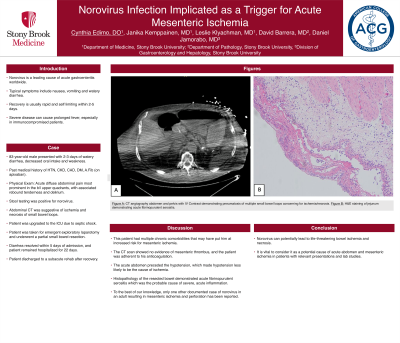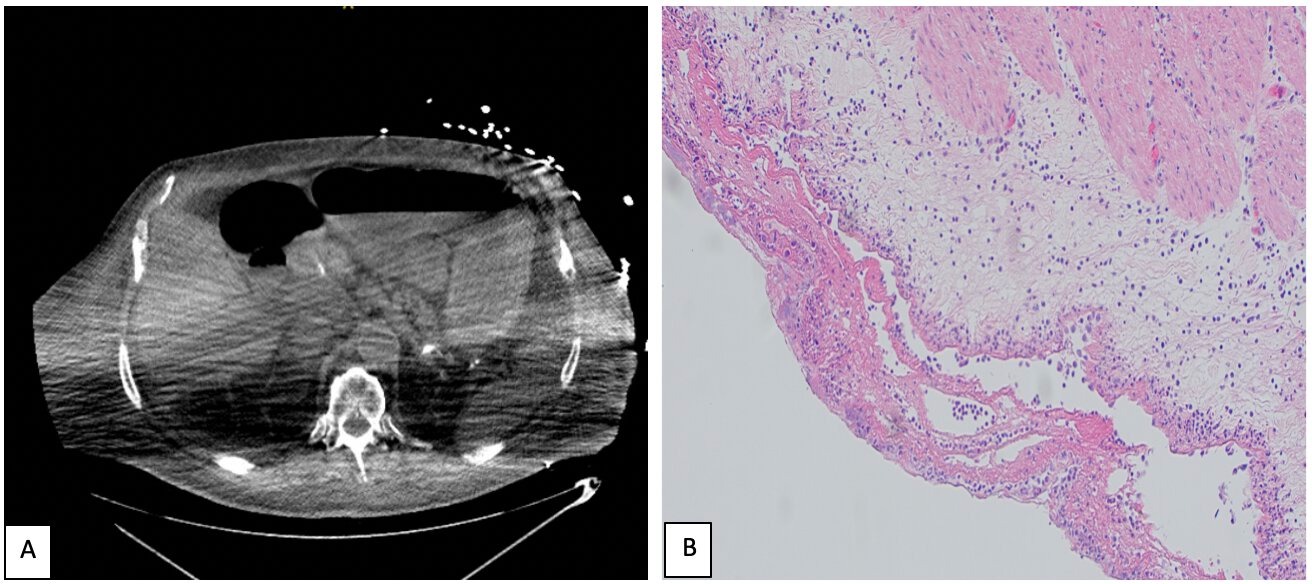Sunday Poster Session
Category: Small Intestine
P1568 - Norovirus Infection Implicated as a Trigger for Acute Mesenteric Ischemia
Sunday, October 27, 2024
3:30 PM - 7:00 PM ET
Location: Exhibit Hall E

Has Audio

Cynthia Edimo, DO
Stony Brook University Hospital
Stony Brook, NY
Presenting Author(s)
Cynthia Edimo, DO, Janika Kemppainen, MD, Leslie Klyachman, MD, David Barrera, MD, Daniel Jamorabo, MD
Stony Brook University Hospital, Stony Brook, NY
Introduction: Norovirus is a leading cause of acute gastroenteritis worldwide. It typically presents with nausea, vomiting, and watery diarrhea. While recovery is usually rapid and self-limiting within 2-5 days, severe disease can manifest with prolonged fever, particularly in immunocompromised patients. We present a case of norovirus that progressed to acute mesenteric ischemia and necrosis.
Case Description/Methods: An 83-year-old functionally independent man presented with 2-3 days of watery diarrhea, decreased oral intake and weakness following a mechanical fall at home. His past medical history was notable for hypertension (HTN), chronic kidney disease (CKD), coronary artery disease (CAD), diabetes mellitus, and atrial fibrillation, for which he was taking apixaban. His clinical course was complicated by acute abdominal pain on day 2 that was diffusely tender to palpation, most prominently in the bilateral upper quadrants with associated rebound tenderness and delirium. The patient became hypotensive with escalating pressor support requirements. He was transferred to the intensive care unit and worked up for septic shock. Subsequent virologic stool testing returned positive for Norovirus. Abdominal CT imaging revealed possible pneumatosis of multiple small bowel loops suggestive of ischemia and necrosis (Figure A). Notably, there was no discrete vascular thrombus identified on imaging. The patient was taken for emergent exploratory laparotomy and underwent a partial small bowel resection. His diarrhea resolved within 5 days of admission, and the patient remained hospitalized for 22 days. He was eventually discharged to a subacute rehab after recovery.
Discussion: This patient had multiple chronic comorbidities that may have put him at increased risk for mesenteric ischemia, including HTN, CKD, CAD, diabetes, and atrial fibrillation. The CT scan showed no evidence of mesenteric thrombus, and the patient was adherent to his anticoagulation regimen. The infection workup highlighted Norovirus as the trigger for acute mesenteric ischemia. The histopathology of the resected bowel demonstrated acute fibrinopurulent serositis (Figure B), which was the probable cause of severe, acute inflammation. The acute abdomen preceded the hypotension, which made hypotension less likely to be the cause of ischemia. To the best of our knowledge, only one other documented case of Norovirus in an adult resulting in mesenteric ischemia and perforation has been reported.

Disclosures:
Cynthia Edimo, DO, Janika Kemppainen, MD, Leslie Klyachman, MD, David Barrera, MD, Daniel Jamorabo, MD. P1568 - Norovirus Infection Implicated as a Trigger for Acute Mesenteric Ischemia, ACG 2024 Annual Scientific Meeting Abstracts. Philadelphia, PA: American College of Gastroenterology.
Stony Brook University Hospital, Stony Brook, NY
Introduction: Norovirus is a leading cause of acute gastroenteritis worldwide. It typically presents with nausea, vomiting, and watery diarrhea. While recovery is usually rapid and self-limiting within 2-5 days, severe disease can manifest with prolonged fever, particularly in immunocompromised patients. We present a case of norovirus that progressed to acute mesenteric ischemia and necrosis.
Case Description/Methods: An 83-year-old functionally independent man presented with 2-3 days of watery diarrhea, decreased oral intake and weakness following a mechanical fall at home. His past medical history was notable for hypertension (HTN), chronic kidney disease (CKD), coronary artery disease (CAD), diabetes mellitus, and atrial fibrillation, for which he was taking apixaban. His clinical course was complicated by acute abdominal pain on day 2 that was diffusely tender to palpation, most prominently in the bilateral upper quadrants with associated rebound tenderness and delirium. The patient became hypotensive with escalating pressor support requirements. He was transferred to the intensive care unit and worked up for septic shock. Subsequent virologic stool testing returned positive for Norovirus. Abdominal CT imaging revealed possible pneumatosis of multiple small bowel loops suggestive of ischemia and necrosis (Figure A). Notably, there was no discrete vascular thrombus identified on imaging. The patient was taken for emergent exploratory laparotomy and underwent a partial small bowel resection. His diarrhea resolved within 5 days of admission, and the patient remained hospitalized for 22 days. He was eventually discharged to a subacute rehab after recovery.
Discussion: This patient had multiple chronic comorbidities that may have put him at increased risk for mesenteric ischemia, including HTN, CKD, CAD, diabetes, and atrial fibrillation. The CT scan showed no evidence of mesenteric thrombus, and the patient was adherent to his anticoagulation regimen. The infection workup highlighted Norovirus as the trigger for acute mesenteric ischemia. The histopathology of the resected bowel demonstrated acute fibrinopurulent serositis (Figure B), which was the probable cause of severe, acute inflammation. The acute abdomen preceded the hypotension, which made hypotension less likely to be the cause of ischemia. To the best of our knowledge, only one other documented case of Norovirus in an adult resulting in mesenteric ischemia and perforation has been reported.

Figure: Figure A: CT angiography abdomen and pelvis with IV Contrast demonstrating pneumatosis of multiple small bowel loops concerning for ischemia/necrosis.
Figure B: H&E staining of jejunum demonstrating acute fibrinopurulent serositis.
Figure B: H&E staining of jejunum demonstrating acute fibrinopurulent serositis.
Disclosures:
Cynthia Edimo indicated no relevant financial relationships.
Janika Kemppainen indicated no relevant financial relationships.
Leslie Klyachman indicated no relevant financial relationships.
David Barrera indicated no relevant financial relationships.
Daniel Jamorabo indicated no relevant financial relationships.
Cynthia Edimo, DO, Janika Kemppainen, MD, Leslie Klyachman, MD, David Barrera, MD, Daniel Jamorabo, MD. P1568 - Norovirus Infection Implicated as a Trigger for Acute Mesenteric Ischemia, ACG 2024 Annual Scientific Meeting Abstracts. Philadelphia, PA: American College of Gastroenterology.
